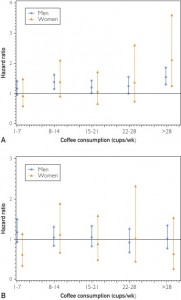Probably overselling it
The Herald has a story about hazards of coffee. The picture caption says
Men who drink more than four cups a day are 56 per cent more likely to die.
which is obviously not true: deaths, as we’ve observed before, are fixed at one per customer. The story says
It’s not that people are dying at a rapid rate. But men who drink more than four cups a day are 56 per cent more likely to die and women have double the chance compared with moderate drinkers, according to the The University of Queensland and the University of South Carolina study.
What the study actually reported was rates of death: over an average of 17 years, men who drink more than four cups a day died at about a 21% higher rate, with little evidence of any difference in men. After they considered only men and women under 55 (which they don’t say was something they had planned to do), and attempted to control for a whole bunch of other factors, the rate increase went to 56% for men, but with a huge amount of uncertainty. Here are their graphs showing the estimate and uncertainty for people under 55 (top panel) and over 55 (bottom panel)
There’s no suggestion of an increase in people over 55, and a lot of uncertainty in people under 55 about how death rates differed by coffee consumption.
In this sort of situation you should ask what else is already known. This can’t have been the first study to look at death rates for different levels of coffee consumption. Looking at the PubMed research database, one of the first hits is a recent meta-analysis that puts together all the results they could find on this topic. They report
This meta-analysis provides quantitative evidence that coffee intake is inversely related to all cause and, probably, CVD mortality.
That is, averaging across all 23 studies, death rates were lower in people who drank more coffee, both men and women. It’s just possible that there’s an adverse effect only at very high doses, but the new study isn’t very convincing, because even at lower doses it doesn’t show the decrease in risk that the accumulated data show.
So. The new coffee study has lots of uncertainty. We don’t know how many other ways they tried to chop up the data before they split it at age 55 — because they don’t say. Neither their article nor the press release gave any real information about past research, which turns out to disagree fairly strongly.
Thomas Lumley (@tslumley) is Professor of Biostatistics at the University of Auckland. His research interests include semiparametric models, survey sampling, statistical computing, foundations of statistics, and whatever methodological problems his medical collaborators come up with. He also blogs at Biased and Inefficient See all posts by Thomas Lumley »

Why are the hazard ratios more precise for men than women? Is this some actuarial effect I don’t know about? Not just that they sampled more men than women coffee drinkers surely.
And I know that I shouldn’t over interpret data like this but the under-55 means for male and female look strangely correlated. Or do they?
And surely had they aggregated male and female under-55s they would still have got a signal and there would have been no reason to stratify other than the different precisions.
I think this is another case where the researchers have not appreciated Tukey’s distinction between exploratory and confirmatory data analysis.
12 years ago
There are two reasons the intervals for men are narrower. The actuarial effect that men die younger is part of it, but more important is that there were three times as many men as women in the study.
12 years ago